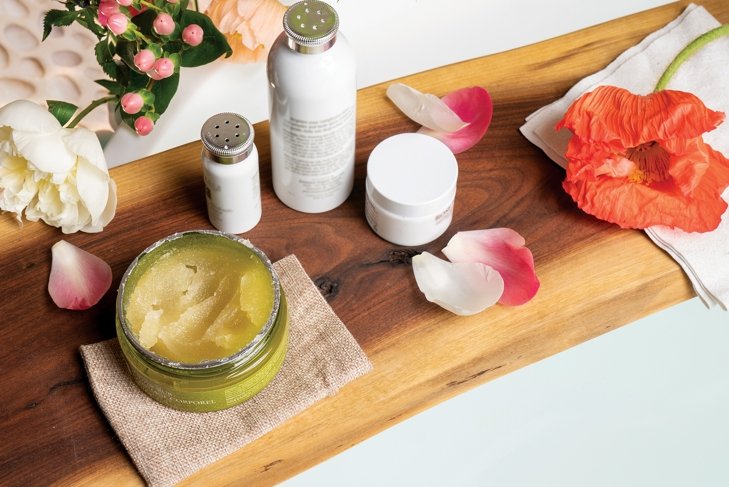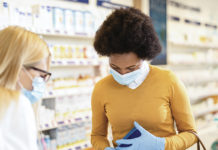
How can you choose truly clean beauty products? Start by learning about preservatives, packaging, and pigments that could be hurting you—and then focus on better alternatives.
Whether or not you enjoy wearing cosmetics, you likely use soap, shampoo, some kind of skin moisturizer, and deodorant on a regular basis. And while even natural beauties want to smell clean, the ingredients in some of these products could cause ugly consequences for
your health.
Here’s a quick and dirty rundown of what to watch for in your personal care products.
Hidden Dangers
Toxins in personal care products are often chemicals intended to keep bacteria from spoiling your purchase. Unfortunately, some of these preservatives have been identified as eye, lung, and skin irritants. Some are even carcinogens and have been implicated in causing DNA damage to sperm. The trade-off hardly seems worth it.
For example, because it is an effective preservative, formaldehyde is frequently found in beauty products such as nail polish and treatments, as well as in keratin hair straighteners. At best, formaldehyde is a lung, eye, nose, throat, and skin irritant, and it is associated with asthma in children. At worst, it is a suspected carcinogen. And while you may be quite happy to avoid embalming fluid in your moisturizer, you may not
know that other preservatives release formaldehyde slowly over time.
Some of the most common formaldehyde releasers in personal care products include DMDM hydantoin, quaternium-15, and imidazolidinyl or diazolidinyl urea. Perhaps not surprisingly, research suggests these ingredients trigger skin hypersensitivity and should not be used by people with atopic dermatitis—or
maybe anyone.
Parabens are another family of chemical preservatives that have toxic effects on our health. Used because they are inexpensive and tend not to cause sensitivity reactions on skin, parabens (especially methylparaben) have been found intact in skin, body fat, umbilical cord blood, placenta, breast milk of lactating women, amniotic fluid, seminal fluid, and urine, as well as in both healthy breast and breast tumour tissues. Because they accumulate in tissues, the safe level of exposure to parabens is none at all.
Preserve your health
While no individual natural preservative works as well as its chemical counterparts, combining several of them in one formula can provide clean,
broad-spectrum protection.
Look for beauty and body care products that take advantage of the natural antimicrobial activity of essential oils. For example, Lavandula augustifolia (lavender), Melaleuca alternifolia (tea tree), and Cinnamomum zeylanicum (Ceylon cinnamon) essential oils were shown in one study to provide greater microbial protection than the chemical preservative methylparaben against pathogens. Those pathogens include Staphylococcus aureus, bacteria that often cause skin infections, and E. coli.
Honey is another valuable addition to a formulation because it regulates pH to thwart infections. This skin-softening ingredient also attracts and traps water in the skin. Manuka honey has particularly strong antibacterial activity and inhibits methicillin-resistant Staphylococcus aureus (MRSA) strains.
Packaging can also help to prevent product spoilage—think pumping systems, one-way valve tops, and tubes with narrow openings. Use a clean spatula with all products that come in jars, and be sure to wash applicators regularly.
Mimicry is cruel
Xenoestrogens (say “zeeno-estrogens”) are chemicals that mimic some structural parts of estrogen, so they are able to bind to receptor sites and act as or interfere with your body’s natural estrogens. Parabens are xenoestrogens, and there are many others found in personal care products.
Used in some plastics and nail polish, phthalates (say “thay-lates”) are a cause for concern. Diisobutyl phthalate (DiBP) has been shown in animal studies to cause male reproductive and developmental toxicities, as well as female reproductive and liver toxicity. In addition, studies suggest phthalates may promote obesity. Prenatal exposure is also a concern.
Bisphenol A is another well-known xenoestrogen that is still used in packaging to increase plasticity, so look for BPA-free plastic containers and canned goods. Metalloestrogens include aluminum, antimony, barium, cadmium, cobalt, copper, lead, mercury, nickel, and others, so you’ll want to limit your exposure to those as well.
Extracts of Matricaria chamomilla (German camomile), aloe vera, and Calendula officinalis (marigold) also show antimicrobial activity.
For a one-page guide to the top 10 toxins to avoid in personal care products, head to environmentaldefence.ca/toxicten.
There are 42 formaldehyde releasers in use in blush, eye shadow, shampoo, toiletries, and other household products.
Toxic tints
The colours in your cosmetics are worth scrutinizing too.
Many pigments are identified on ingredient lists with the letters CI (colour index), followed by a number. They may also appear as the letters D&C (drug and cosmetic use) followed by the name of a colour and a number. Some of these colours have been found to be irritants. Several have been restricted over the decades due to cancer links.
Research is ongoing into the safety of these pigments. For example, a recent laboratory study found that dyes that are frequently used in leave-on products such as face creams, foundations, lipsticks, and even sunscreen products (CI 45410, CI 45380, and CI 75810) are activated by sunlight, leading to free radical production, phototoxic effects, and DNA damage. CI 45410 was found to potentially cause genetic mutations even without exposure to sunlight.
The metalloestrogens copper and aluminum are also used as pigments in personal care products.
Certainly, many synthetic colours appear to be safe, but why take a chance? Opt for personal care products that use plant-derived and natural pigments. Natural and mineral makeups have come a long way in the last decade. We no longer have to choose between muddy, flat shades of orange-brown. Look for creams and powders in the textures and shades you’ve come to expect from high-fashion brands.
Many clean makeups use iron oxides for pigment. These chemical compounds are composed of iron and oxygen and occur as yellow, red, black, or brown powder. Mica is a typically off-white, shimmery mineral that is often used as a base for brighter pigments in eyeshadows and blush. White titanium dioxide can be added pigments to create tints.
Vibrant red is the most challenging colour to create naturally. Carmine, for example, is a red pigment created by boiling cochineal insects. Cruelty-free lines will not include carmine.
You can also find ingredients like curcumin from the spice turmeric to offer yellow-orange hues for skincare products. Derived from the seeds of the achiote tree, annatto is another natural yellow-orange dye.
Natural hair colours provide a fresh take on henna with combinations of fruit and flower oils that provide a semi-permanent finish.
The bottom line when it comes to choosing personal care and beauty products is that you have to be an informed consumer. For support, talk to the experts at your local natural health retailer. Many stores have strict policies about what ingredients are allowed on their shelves. You’re not likely to find any ugly surprises there!
What is clean beauty?
> Nontoxic ingredients: Ingredients can be natural or synthetic, but not toxic.
> Honest and transparent labels: All ingredients are listed rather than being lumped under an umbrella term, such as “fragrance.”
> Simple formulas: Less is more.
What is green beauty?
> Eco-friendly
> Cruelty free
> Plant derived
> Sustainably sourced
Clean collagen?
If you supplement with collagen—which has been linked with reduced signs of skin aging and increased skin moisture—pay attention to how your collagen has been sourced.
When shopping for livestock-derived collagen, such as bovine (cattle) or porcine (pig) collagen, choose a supplement that’s certified organic. As with choosing other organic animal products, this helps minimize your potential exposure to toxins. If you’re keen to try marine collagen, seek out a product derived from sustainably sourced seafood. You can expect to see a growing number of sustainable marine collagen supplements hitting shelves as studies and supply chains expand.
Here are a few other tips for buying collagen.
> Choose hydrolyzed collagen. This is collagen that’s been broken down into smaller segments (called “peptides”). It’s easier to absorb.
> Consider combination products. You may get added benefits by choosing products that combine collagen with other skin-loving nutrients, such as vitamin C.
> Know your priorities. Do you want to quickly take collagen with minimum fuss? A liquid supplement might be your best choice. Prefer not to taste your collagen? Opt for a powder that can be mixed into foods or beverages.
Seal of approval
In both Canada and the US, you may see seals or statements indicating a personal care product is organic or contains organic ingredients.
For example, you’ll often spot USDA (United States Department of Agriculture) Organic certified body care products at your local natural health retailer. This means all or some of the ingredients were grown without the use of genetically modified organisms (GMOs) or harsh pesticides and that soil health and biologically based farming methods were prioritized.
Here’s how to decode those USDA seals and statements to know exactly what you’re getting.
| USDA Organic certification | What it means |
| “100 percent organic” (usually accompanied by USDA Orgainc Seal) | the gold standard: contains 100 percent certified organic ingredients |
| “Organic” (usually accompanied by USDA Organic Seal) |
> contains at least 95 percent organic ingredients > the remaining 5 percent must be permitted ingredients > any agricultural ingredients in the product must be organic unless unavailable |
| “Made with organic _____” (up to three specific ingredients) |
> contains at least 70 percent organic ingredients > the remaining 30 percent must be allowed ingredients |
Products made with less than 70 percent organic ingredients can mention specific organic ingredients only in the ingredients list—not elsewhere on the packaging.













